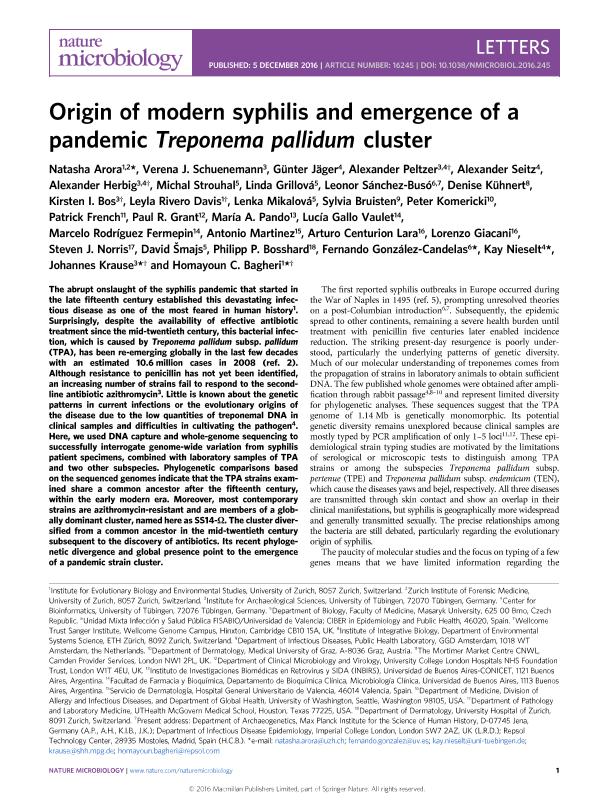Artículo
Origin of modern syphilis and emergence of a pandemic Treponema pallidum cluster
Arora, Natasha; Schuenemann, Verena J.; Jäger, Hünter; Peltzer, Alexander; Seitz, Alexander; Herbig, Alexander; Strouhal, Michal; Grillová, Linda; Sánchez Busó, Leonor; Kühnert, Denise; Bos, Kirsten I.; Davis Rivero, Leyla; Mikalová, Lenka; Bruisten, Sylvia; Komericki, Peter; French, Patrick; Grant, Paul R.; Pando, María de los Ángeles ; Gallo Vaulet, Maria Lucia; Rodríguez Fermepin, Marcelo; Martinez, Antonio; Lara, Arturo Centurión; Giacani, Lorenzo; Norris, Steven J.; Smajs, David; Bosshard, Philipp P.; González Candelas, Fernando; Nieselt, Kay; Krause, Johannes; Bagheri, Homayoun C.
; Gallo Vaulet, Maria Lucia; Rodríguez Fermepin, Marcelo; Martinez, Antonio; Lara, Arturo Centurión; Giacani, Lorenzo; Norris, Steven J.; Smajs, David; Bosshard, Philipp P.; González Candelas, Fernando; Nieselt, Kay; Krause, Johannes; Bagheri, Homayoun C.
 ; Gallo Vaulet, Maria Lucia; Rodríguez Fermepin, Marcelo; Martinez, Antonio; Lara, Arturo Centurión; Giacani, Lorenzo; Norris, Steven J.; Smajs, David; Bosshard, Philipp P.; González Candelas, Fernando; Nieselt, Kay; Krause, Johannes; Bagheri, Homayoun C.
; Gallo Vaulet, Maria Lucia; Rodríguez Fermepin, Marcelo; Martinez, Antonio; Lara, Arturo Centurión; Giacani, Lorenzo; Norris, Steven J.; Smajs, David; Bosshard, Philipp P.; González Candelas, Fernando; Nieselt, Kay; Krause, Johannes; Bagheri, Homayoun C.
Fecha de publicación:
11/2016
Editorial:
Springer
Revista:
Nature Microbiology
ISSN:
2058-5276
Idioma:
Inglés
Tipo de recurso:
Artículo publicado
Clasificación temática:
Resumen
The abrupt onslaught of the syphilis pandemic that started in the late fifteenth century established this devastating infectious disease as one of the most feared in human history1 . Surprisingly, despite the availability of effective antibiotic treatment since the mid-twentieth century, this bacterial infection, which is caused by Treponema pallidum subsp. pallidum (TPA), has been re-emerging globally in the last few decades with an estimated 10.6 million cases in 2008 (ref. 2). Although resistance to penicillin has not yet been identified, an increasing number of strains fail to respond to the secondline antibiotic azithromycin3. Little is known about the genetic patterns in current infections or the evolutionary origins of the disease due to the low quantities of treponemal DNA in clinical samples and difficulties in cultivating the pathogen4. Here, we used DNA capture and whole-genome sequencing to successfully interrogate genome-wide variation from syphilis patient specimens, combined with laboratory samples of TPA and two other subspecies. Phylogenetic comparisons based on the sequenced genomes indicate that the TPA strains examined share a common ancestor after the fifteenth century, within the early modern era. Moreover, most contemporary strains are azithromycin-resistant and are members of a globally dominant cluster, named here as SS14-Ω. The cluster diversified from a common ancestor in the mid-twentieth century subsequent to the discovery of antibiotics. Its recent phylogenetic divergence and global presence point to the emergence of a pandemic strain cluster.
Palabras clave:
TREPONEMA PALLIDUM
,
ORIGIN OF SYPHILIS
Archivos asociados
Licencia
Identificadores
Colecciones
Articulos(INBIRS)
Articulos de INSTITUTO DE INVESTIGACIONES BIOMEDICAS EN RETROVIRUS Y SIDA
Articulos de INSTITUTO DE INVESTIGACIONES BIOMEDICAS EN RETROVIRUS Y SIDA
Citación
Arora, Natasha; Schuenemann, Verena J.; Jäger, Hünter; Peltzer, Alexander; Seitz, Alexander; et al.; Origin of modern syphilis and emergence of a pandemic Treponema pallidum cluster; Springer; Nature Microbiology; 2; 16245; 11-2016; 1-6
Compartir
Altmétricas



